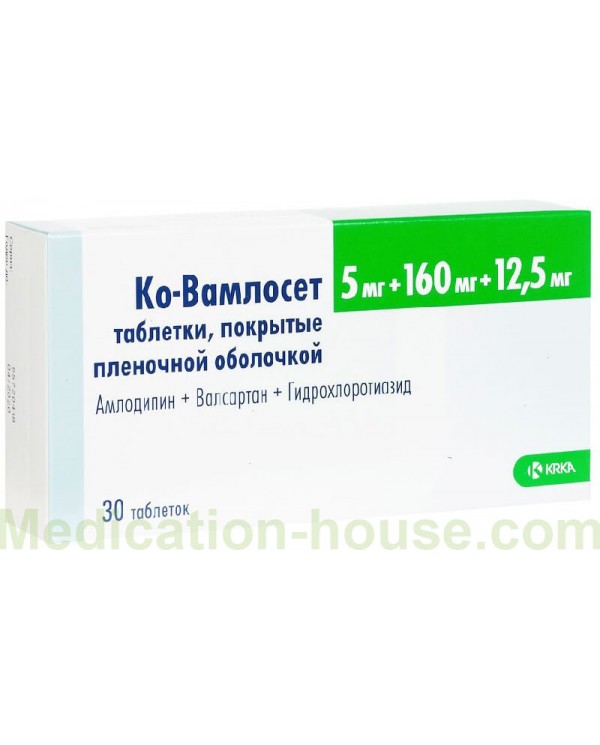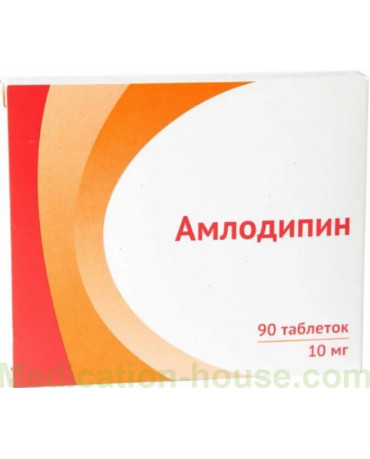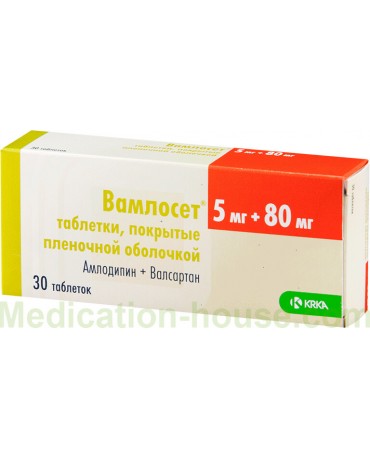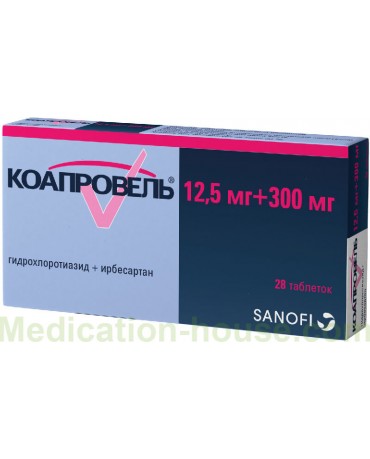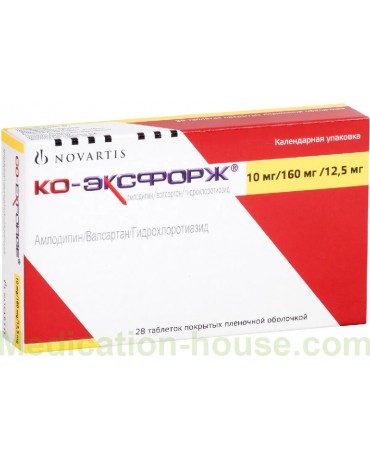Instruction for Co-Vamloset
Reed more and buy Co-Vamloset on this page
Co-Vamloset is an antihypertensive drug.
Release form and composition
Dosage form of Co-Vamloset - film-coated tablets, oval, biconvex:
dosage 5 mg + 160 mg + 12.5 mg: white, engraved with "K1" on one side;
dosage 10 mg + 160 mg + 12.5 mg: pink, engraved with "K2" on one side;
dosage 10 mg + 160 mg + 25 mg: brownish yellow, engraved with "K4" on one side.
Tablets are packed in blisters of 7, 10, 14 or 15 pcs. Instructions for the use of Co-Vamloset and 1, 2, 4, 8, 12 or 14 blisters containing 7 tablets each, or 1, 2, 3, 6 or 9 blisters containing 10 tablets each, or 1, 2 , 4, 6 or 7 blisters containing 14 tablets, or 1, 2, 4 or 6 blisters containing 15 tablets.
Composition of 1 tablet Co-Vamloset (5 mg + 160 mg + 12.5 mg / 10 mg + 160 mg + 12.5 mg / 10 mg + 160 mg + 25 mg):
active substances: amlodipine besylate - 6.94 / 13.88 / 13.88 mg (equivalent to the content of amlodipine - 5/10/10 mg), valsartan A (granular substance) - 251.35 mg (equivalent to the content of valsartan - 160 mg ), hydrochlorothiazide - 12.5 / 12.5 / 25 mg;
auxiliary components: colloidal silicon dioxide, magnesium stearate, mannitol;
excipients of the granule substance: povidone, crospovidone, microcrystalline cellulose, sodium lauryl sulfate;
film shell: film-forming mixture (talc, titanium dioxide, macrogol 3350, polyvinyl alcohol); 10 mg + 160 mg + 12.5 mg tablets additionally contain iron oxide red dye (E172), 10 mg + 160 mg + 25 mg tablets - iron oxide yellow dye (E172).
Pharmacodynamics
Co-Vamloset is a drug containing three antihypertensive components, each of which complements the action of the others aimed at controlling blood pressure (BP):
amlodipine: a dihydropyridine derivative, slow calcium channel blocker (BMCC). It has a direct relaxing effect on vascular smooth muscles, which helps to reduce total peripheral resistance (OPSS) and blood pressure, without causing a significant decrease in heart rate (HR). With normal renal function, it decreases renal vascular resistance, increases the glomerular filtration rate (GFR) and effective renal plasma flow;
valsartan: an angiotensin II receptor antagonist (ARA II) that selectively acts on the AT1 receptor subtype responsible for the effects of angiotensin II. Reduces blood pressure without affecting heart rate. In chronic heart failure of II-IV functional class according to the classification of the New York Heart Association (NYHA), valsartan significantly reduces the number of hospitalizations for diseases of the cardiovascular system, with left ventricular failure (with stable hemodynamic parameters) and impaired left ventricular function in patients who have undergone myocardial infarction, reduces cardiovascular mortality;
hydrochlorothiazide: a thiazide diuretic. By acting on the sensitive receptors of the distal tubules of the renal cortex, hydrochlorothiazide inhibits the reabsorption of chloride and sodium ions. Due to the diuretic effect, the volume of circulating blood (BCC) decreases, which leads to an increase in renin activity and aldosterone secretion, an increase in the excretion of potassium by the kidneys and, as a consequence, a decrease in the level of potassium in the blood serum.
The active substances of Co-Vamloset in combination cause a more pronounced decrease in blood pressure than each of them separately.
Pharmacokinetics
The main pharmacokinetic characteristics of amlodipine:
absorption: the maximum plasma concentration (Cmax) is observed 6-12 hours after taking amlodipine inside. Absolute bioavailability can vary from 64 to 80% and does not depend on the timing of meals;
distribution: the volume of distribution (Vd) is approximately 21 l / kg. Plasma protein binding is about 97.5%;
metabolism: about 90% of the dose of amlodipine is biotransformed in the liver, as a result of which metabolites with pharmacological activity are formed;
excretion: amlodipine is excreted from plasma in two phases with a half-life (T1 / 2) of 30-50 hours. Stationary concentrations (Css) are achieved within 7-8 days. The drug is excreted from the body mainly in the form of metabolites (60%), to a lesser extent unchanged (10%).
The main pharmacokinetic parameters of valsartan:
absorption: Cmax is observed 2-4 hours after taking valsartan inside. The absolute bioavailability averages 23%, with simultaneous food intake this indicator slightly decreases, which does not significantly affect the clinical effect;
distribution: after intravenous administration of valsartan, Vd during the equilibrium state is about 17 liters, which indicates the absence of extensive distribution of the drug in the tissues. To a high degree (94–97%) it binds to serum proteins, mainly albumin;
metabolism: valsartan does not undergo pronounced metabolism (no more than 20% of the dose taken is biotransformed). The main hydroxyl metabolite, which does not exhibit pharmacological activity, is determined in plasma at low concentrations (<10% of the AUC of the main substance);
excretion: excreted mainly unchanged through the intestines (83%), to a lesser extent by the kidneys (13%). T1 / 2 is 6 hours.
The main pharmacokinetic parameters of hydrochlorothiazide:
absorption: Cmax is observed approximately 2 hours after taking hydrochlorothiazide inside. Bioavailability is on average 70%; simultaneous food intake can both increase and decrease this indicator. This fact has no significant clinical significance;
distribution: the kinetics of distribution and elimination of hydrochlorothiazide is described as a biexponential decreasing function. With long-term treatment, the kinetics does not change. If the substance is taken once a day, its accumulation in the body is minimal. The apparent Vd is 4–8 l / kg. The connection with plasma proteins, mainly albumin, is 40–70%. Hydrochlorothiazide accumulates in erythrocytes, while the concentration here is about 3 times higher than that in blood plasma;
metabolism: hydrochlorothiazide is not metabolized in the human body;
withdrawal: displayed unchanged. T1 / 2 is 6-15 hours. More than 90% of the absorbed dose is excreted by the kidneys unchanged.
When taking Co-Vamloset, Cmax of amlodipine, valsartan and hydrochlorothiazide are achieved after 6-8, 3 and 2 hours, respectively.
Pharmacokinetics in certain groups of patients:
advanced age: in patients over 65 years of age, the clearance of amlodipine slightly decreases, which causes an increase in the area under the concentration-time curve (AUC) and T1 / 2;
renal failure: the pharmacokinetics of amlodipine and valsartan do not change significantly. In hydrochlorothiazide, Cmax and AUC increase, the rate of excretion decreases, with renal dysfunction of mild or moderate severity, its T1 / 2 increases almost 2 times;
hepatic failure: the clearance of amlodipine decreases, which increases its AUC by 40-60%. The bioavailability of valsartan (by AUC) increases 2 times.
Indications for use
Co-Vamloset is used for the treatment of II and III degree arterial hypertension.
Contraindications
Absolute:
severe arterial hypotension (systolic blood pressure <90 mm Hg);
aortic stenosis, which is of clinical importance;
hemodynamically unstable heart failure in patients with acute myocardial infarction;
cardiogenic shock, collapse;
hyperuricemia with clinical manifestations, as well as hypercalcemia, hyponatremia and / or hypokalemia, if these conditions are refractory to standard therapy;
severe functional impairment of the kidneys [creatinine clearance (CC) <30 ml / min], anuria, hemodialysis;
cholestasis, liver failure of any degree, biliary cirrhosis;
angioedema (hereditary or caused by previous therapy with ARA II);
age under 18;
pregnancy planning period, pregnancy and breastfeeding;
simultaneous use of medicines containing aliskiren - for patients with diabetes mellitus and / or impaired renal function (GFR <60 ml / min / 1.73 m2 of body surface area);
joint administration of ACE inhibitors - for patients with diabetic nephropathy;
hypersensitivity to any component of Co-Vamloset, other sulfonamide or dihydropyridine derivatives.
Relative (special care is required, assessing the balance of benefits and risks): angle-closure glaucoma, systemic lupus erythematosus, hypercalcemia, hypochloremia, hypomagnesemia, hyponatremia, hypokalemia, hypertrophic obstructive cardiomyopathy, mitral / aortic stenosis, coronary syndrome III, chronic cardiac insufficiency class according to the NYHA classification, hyperuricemia, diabetes mellitus, conditions accompanied by a decrease in BCC and impaired water-electrolyte metabolism (prerenal renal dysfunction), nephropathy accompanied by salt loss), moderate renal dysfunction (GFR 30-60 ml / min / 1, 73 m2 body surface area), unilateral / bilateral stenosis of the renal arteries or stenosis of an artery of a solitary kidney, conditions after kidney transplantation, a history of non-melanoma skin cancer, elevated plasma cholesterol and triglyceride concentrations, advanced age, concomitant use of potassium-containing pi substitutes salt, potassium-sparing diuretics, potassium salts, drugs that can increase the plasma level of potassium (for example, heparin).
Co-Vamloset, instructions for use: method and dosage
Co-Vamloset is intended for oral administration. The tablets must be swallowed whole with sufficient water. Meal timing doesn't matter. Frequency rate of admission - 1 time per day.
The doctor determines the required dosage of tablets for each patient individually by titrating the doses of the individual components of Co-Vamloset. The dose should be increased no earlier than 2 weeks after the start of treatment, since it is by this time that the maximum effect develops.
If the patient is already receiving therapy with drugs containing amlodipine, valsartan and hydrochlorothiazide separately, he can be transferred to Co-Vamloset tablets containing the same doses of active substances.
Patients over 65 are advised to start treatment with a minimum dose of amlodipine, i.e. from Co-Vamloset tablets containing 5 mg of this medicinal substance.
Side effects
metabolism: often - hypokalemia; infrequently - hyperlipidemia, hypercalcemia, hyperuricemia, hyponatremia;
cardiovascular system: often - a marked decrease in blood pressure; infrequently - phlebitis, thrombophlebitis, orthostatic hypotension, tachycardia;
respiratory system: infrequently - sore throat / irritation in the throat, shortness of breath, cough;
nervous system: often - headache, dizziness; infrequently - drowsiness, sleep disturbances (including insomnia), dysgeusia, dizziness on exertion, postural dizziness, lethargy, ataxia, paresthesia, taste distortion, neuropathy (including peripheral), fainting;
digestive system: often - dyspepsia syndrome; infrequently - dry mouth, bad breath, abdominal discomfort, diarrhea, upper abdominal pain, anorexia, nausea, vomiting;
urinary system: often - pollakiuria; infrequently - an increase in the plasma concentration of creatinine, acute renal failure;
musculoskeletal system: infrequently - muscle spasms, swelling in the joints, pain in the limbs / back, myalgia, muscle weakness;
sense organs: infrequently - vertigo, blurred vision; frequency unknown - acute angle-closure glaucoma;
reproductive system: infrequently - erectile dysfunction;
dermatological reactions: infrequently - itching of the skin, increased sweating; rarely - photosensitivity reaction;
others: often - fatigue, peripheral edema; infrequently - general weakness, asthenia, gait disturbance, chest pain of non-cardiac origin, abasia, increased body weight;
laboratory parameters: infrequently - hyperuricemia, an increase in the plasma level of urea nitrogen, a decrease in the content of potassium in the blood plasma.
Overdose
Overdose cases have not been reported, but if the recommended dose of Co-Vamloset is exceeded, active substances can cause the following reactions:
valsartan: marked decrease in blood pressure, dizziness;
amlodipine: excessive peripheral vasodilation, reflex tachycardia, pronounced and prolonged decrease in blood pressure, up to shock and death.
If the tablets are recently taken, it is recommended to wash out the stomach or induce vomiting, drink activated charcoal.
With a pronounced decrease in blood pressure, the patient should be laid on a horizontal surface and his legs should be slightly raised. Further, it is required to carry out active measures to maintain the work of the cardiovascular system, control the activity of the heart and respiratory system, BCC and the amount of urine excreted.
If there are no contraindications to vasopressor drugs, they are used to maintain normal vascular tone.
Hemodialysis is not effective for removing amlodipine and valsartan, but the procedure can remove hydrochlorothiazide from the body.
Special instructions
Co-Vamloset is not intended for relief of hypertensive crisis.
In the presence of hypovolemia and / or sodium deficiency, these conditions must be corrected before taking Co-Vamloset.
Hydrochlorothiazide is able to alter glucose tolerance, increase serum concentrations of uric acid, cholesterol and triglycerides. Patients with diabetes mellitus often require a change in the dose of oral hypoglycemic agents or insulin.
If photosensitivity develops, Co-Vamloset is recommended to be canceled. If it is necessary to carry out further therapy with a diuretic, the areas of the skin exposed to sunlight should be protected.
The hydrochlorothiazide contained in this medicine can cause false positive doping test results in athletes.
In pharmacoepidemiological studies, a link has been established between the use of hydrochlorothiazide and the risk of developing non-melanocytic skin cancer (NMSC) - squamous and basal cell carcinomas. With an increase in the accumulated dose, the danger increases. It is assumed that the mechanism of NMSC development is based on the photosensitizing effect of hydrochlorothiazide. Doctors should warn about this risk to every patient who is prescribed hydrochlorothiazide, including as part of combination drugs. It is also recommended to periodically examine your skin and, if suspicious neoplasms or changes in existing skin lesions appear, immediately inform your doctor. To minimize the risk of developing NMSC, preventive measures should be followed: limit exposure to sunlight and ultraviolet rays, use sunscreens. Individuals with a history of NMSC should carefully consider the appropriateness of prescribing drugs containing hydrochlorothiazide.
Influence on the ability to drive vehicles and complex mechanisms
Co-Vamloset can cause side effects that negatively affect the ability to concentrate and the speed of psychomotor reactions, for example, visual impairment, dizziness. In this regard, when driving vehicles and working with complex mechanisms during therapy, special care must be taken.
Application during pregnancy and lactation
Co-Vamloset is contraindicated for women planning pregnancy, pregnant and breastfeeding women.
If pregnancy is diagnosed during therapy, the drug is immediately discontinued and an alternative treatment is prescribed. If it is necessary to prescribe Co-Vamloset during lactation, feeding should be stopped.
Childhood use
An antihypertensive agent is not prescribed for patients under the age of 18.
With impaired renal function
Co-Vamloset is contraindicated in patients with severe functional impairment of the kidneys, anuria, and also receiving hemodialysis.
The drug is prescribed with caution for moderate renal dysfunction (GFR 30-60 ml / min / 1.73 m2 of body surface area), prerenal renal dysfunction, nephropathy (if it is accompanied by loss of salts), with unilateral / bilateral renal artery stenosis (stenosis of the only arteries, if there is only one kidney), as well as in conditions after kidney transplantation.
For violations of liver function
Co-Vamloset is contraindicated in patients with hepatic insufficiency, cholestasis and biliary cirrhosis.
Use in the elderly
Co-Vamloset should be used with caution in old age. Treatment should be carried out under frequent blood pressure monitoring.
Drug interactions
The antihypertensive drug contains three active substances at once, each of which has a high pharmacological activity with clinical significance. In this regard, the possibility of joint use of any other drug at the same time as Co-Vamloset must be agreed with the attending physician.
Terms and conditions of storage
Store in original blister packaging at temperatures up to 25 ° C. Keep out of the reach of children.
Shelf life is 2 years.
Reviews about Co-Vamloset
According to reviews, Co-Vamloset is an inexpensive but effective antihypertensive drug that quickly reduces high blood pressure and maintains it at a normal level throughout the day.
The disadvantages of Co-Vamloset include a large list of contraindications, possible side effects. Before use, users recommend that you always consult a doctor.
Terms of sell
You can buy Co-Vamloset without a prescription.

